The following information on the Mauser Model 71 comes from Chapter 4 of Mauser Rifles and Pistols by W. H. B. Smith. Mauser Rifles and Pistols is also available to purchase in print.
As already pointed out in the Historical Foreword, this arm while officially adopted in 1871 was actually issued in February 1872, with the improved safety demanded by the Testing Commission.
This arm was a single shot breech loader utilizing the bolt principle of the Dreyse and resembling it in many exterior details. However it employed a new cartridge whose case was drawn brass. This cartridge measured 3.07 inches over all and weighed 660.5 grains. The bullet was lead; its length was 1.0827 inches, its diameter (less patch) was 11 mm, (.433 inch), and its weight was 386 grains. The initial charge was approximately 77.16 grains of black powder which developed a muzzle velocity of about 1425 feet per second and gave a maximum range of about 3200 yards.

The rifle itself weighed 10 pounds 4 ounces (1 pound 8 ounces more with bayonet). The overall length was 4 feet, 4.75 inches (6 feet .5-inch with bayonet). The barrel was 33.46 inches long and was rifled with 4-grooves of .0157 inch depth. The rifling made one turn in 21.65 inches (50 calibers) to the right. The sight adjustment ran from 300 meters (328 yards) to 1600 meters (1750 yards). The bore diameter was nominally 11 mm (.433).
This rifle was such a revolutionary development in the art of war that a fairly complete description of it is warranted here. Furthermore, millions of these rifles were distributed throughout the world, very large numbers having been sold in the U.S., particularly by the firm of Bannerman of N.Y.C. Moreover, they appeared in some quantity in use even in World War II in Europe. Ammunition for them was generally manufactured in Europe as late as 1937. Large numbers of them were adapted first in the late ’90’s and later in the early ’20’s to handling shot gun shells. These arms therefore may be encountered in the U.S. in general use as well as in arms collections.
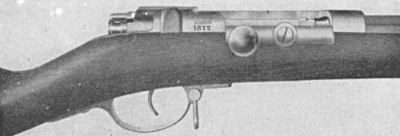
The illustrations here used to show the functioning of this weapon are taken from contemporary drawings officially made by Mauser.
The bolt is fitted into the receiver of the rifle to permit it to travel backward and forward as the bolt handle is raised or lowered and the bolt drawn back or pushed forward.
The bolt cylinder is perforated and has the striker surrounded by its spring mounted within it. Raising the bolt lever permits the bolt to be drawn back. A guide block on the upper surface of the bolt cylinder works between two lips in the receiver bridge to prevent rotation of the cylinder until the guide is clear of the lips.
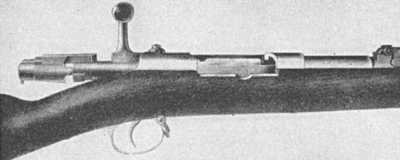
The striker is not removable and is attached by a nut and screw to the cocking piece. The cocking piece can move backward and forward only. It cannot rotate, as the striker is elliptical in section. The movable bolt head is separate from the cylinder; and rotating the cylinder when opening with the lever or when closing does not affect the position of the bolt head or of the striker and its spring. The bolt cylinder works by cam action on the cocking-piece to cock the striker as the bolt handle is manipulated.
The extractor works in a groove in the left side of the bolt cylinder, and is of spring steel. The ejector is mounted in the trigger spring and works through the bolt cylinder and the receiver. A safety lock fitted to the cocking-piece works upon a spring. When applied it drops into a notch in the breechblock (or bolt) and prevents the striker from reaching the cartridge.
Mauser Model 71 Operation
The bolt handle is raised and the bolt is drawn back as far as it will go. A cartridge is inserted in the firing chamber. The breech block is pushed forward until its guide is clear of the receiver bridge slot. It is then turned down to the right to close and seal the breech; and since the nose of the cocking-piece bears against the cylinder cam, it also completes compression of the striker spring ready for firing. Pressure on the trigger is transmitted to release the striker. The striker spring drives the striker forward to fire the cartridge.
When the bolt lever is turned up to open the breech, the head of the bolt and the cocking piece remain in the same relative positions as already indicated. The cam face of the bolt cylinder forces back the cam on the cocking-piece, thereby drawing the striker back into the bolt.
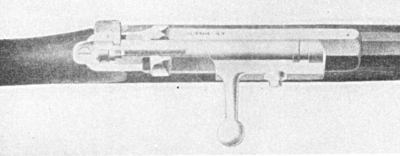
As the bolt is pulled back, the extractor in the face of the bolt draws the empty cartridge case out of the firing chamber with it and strikes it violently against the claw of the ejector causing it to pivot and be hurled out the stop of the breech. This front claw of the ejector projects only when the bolt is drawn all the way back.
Minor modifications of this rifle were made and a short carbine model with wooden forestock extending to the muzzle was also issued.
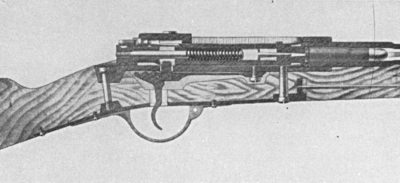
Mauser Model 71 Development
The German government thought so highly of this new development that they arranged banking assistance and turned the great Oberndorf plant over to the Mauser brothers for manufacture of their rifle and for further development.
Shortly thereafter the Mausers were given additional financial help to produce the rifle in quantity for foreign sale. Thus started the concerted efforts of the German High Command to distribute German arms, and with them German methods, ideology and military thought throughout the world.
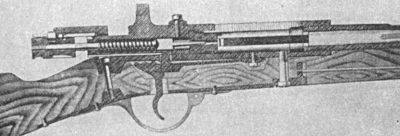
Except for comparatively short periods during World Wars I and II, Germany as a matter of military policy from that day on used every means and every effort to infiltrate and eventually direct the equipment and military policies of small Nations throughout the world. The Mauser arms, together with those of Krupp, were the prime products for the world spread of German military thought. By producing only the finest arms and by providing instructors, technicians and tacticians the Germans were able to develop military commissions which blanketed Europe, Asia and South America, where even today German arms and ideologies are paramount.

Brother Wilhelm, not being very strong physically, undertook the position of traveling salesman for the organization while Paul supervised the plant. In 1876 they sold 26,000 of these model 71’s to China. In 1881 they sold 120,000 to Serbia as indicated in the records of the Mauser company published in the official plant history issued in 1936.
